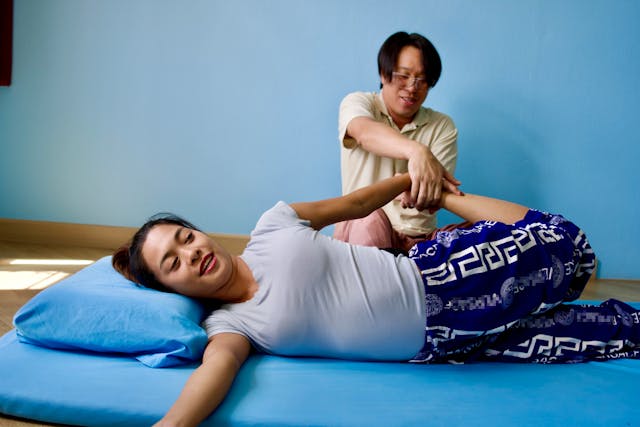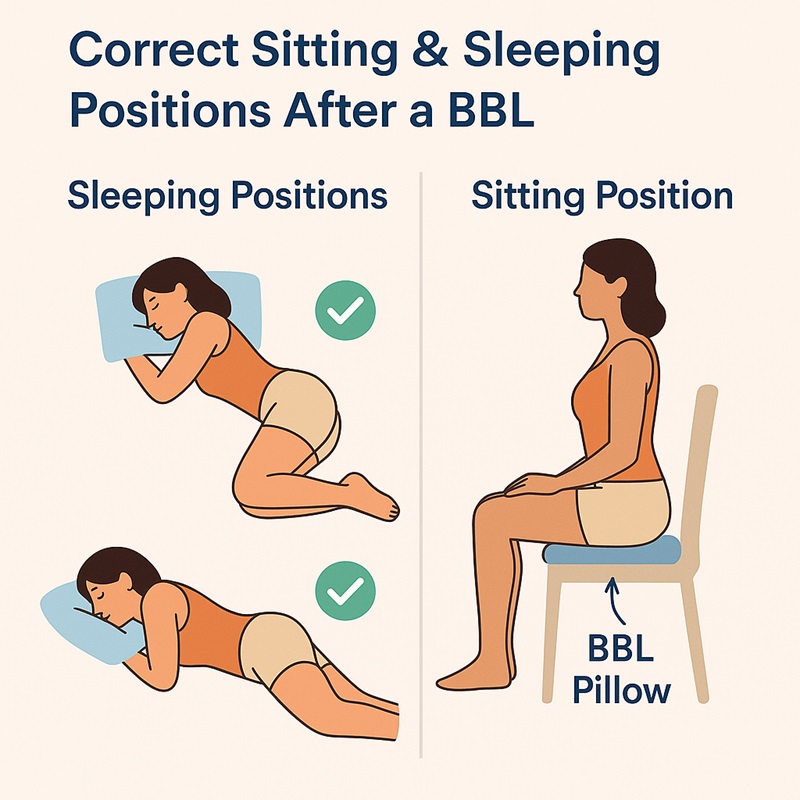Recovering from a Brazilian Butt Lift (BBL) is just as important as the surgery itself. The body works hard to heal incisions, stabilize transferred fat, and adapt to new contours. How you eat, sleep, sit, move, and care for your body in the weeks after surgery can significantly influence your comfort and final results.
This guide covers the essential steps—based on common post-operative practices—to help you support healing and enjoy smoother, more predictable recovery outcomes.
What Is a BBL?
A Brazilian Butt Lift (BBL) is a cosmetic procedure that uses liposuction to remove fat from areas like the abdomen, flanks, or thighs and transfers it to the buttocks to enhance shape and volume. Because the procedure relies on fat survival, careful post-operative recovery plays a major role in the final result.

BBL Recovery Timeline at a Glance
Every person heals at a different pace, but most BBL Healing Process follows the same general pattern.
Week 1
The first week often brings swelling, soreness, and a tight feeling in the hips and buttocks. This is the body’s normal response to surgery. Rest is very important. Most surgeons ask patients not to sit on their buttocks during this stage. Short, slow walks—often with a bit of help—can improve blood flow and reduce stiffness without putting pressure on the new fat.
Weeks 2–3
Most people start to feel better during this time. Swelling and bruising begin to fade, and walking becomes easier. Even with this progress, it is still important to protect the fat grafts. Surgeons usually advise avoiding direct pressure on the buttocks. If sitting is needed, a BBL pillow helps shift weight to the thighs. Many patients also start lymphatic drainage massage during this period to help move fluid and reduce firm spots.
Weeks 4–6
By this stage, many patients feel more like themselves. Light activities—such as gentle stretching or short outings—may be allowed with the surgeon’s approval. Some patients may also be cleared to sit more normally, but this varies based on healing and the surgeon’s method. Most people still wear their compression garment every day to shape the new curves and manage swelling.
3–6 Months
This is when the biggest changes happen. Swelling continues to drop. The shape becomes smoother and more defined. Most of the fat that will stay has now settled. Many patients start to see the fuller, rounder contour they hoped for before surgery. This period often marks the point where results look close to their long-term form.
Nutrition & Hydration: Building Blocks for Faster Healing
In the first few weeks after a BBL, what you eat can have a meaningful impact on how your body heals. Surgery places a high demand on your cells as they repair tissues, rebuild collagen, and stabilize the newly transferred fat. Rather than focusing on restrictive diets, this stage is about choosing nourishing, well-balanced meals that give your body the raw materials it needs to recover efficiently.
Protein & Collagen: Rebuilding Tissue From the Inside Out
Protein is central to the healing process. It provides the amino acids the body uses to regenerate cells, repair tissue, and maintain strength during recovery. Many patients notice that eating enough protein helps them feel more energized and supports overall wound healing. Hydrolyzed collagen can be a helpful addition as well, since it delivers easily absorbed peptides that support skin elasticity and connective tissue strength.
Protein-rich foods like chicken, eggs, Greek yogurt, legumes, quinoa, and bone broth make it easy to meet your daily needs. Collagen peptides can also be added to smoothies, soups, or drinks for an extra boost.
Vitamin C: Supporting Collagen and Calming Inflammation
Vitamin C plays a key role in the body’s ability to produce collagen—an essential part of incision healing and skin recovery. It also acts as a powerful antioxidant, helping reduce inflammation and protect tissues from oxidative stress during the early post-op weeks.
Citrus fruits, berries, bell peppers, kiwi, and broccoli are all vitamin-C–rich options that you can easily include in meals or snacks.
Iron & Copper: Delivering Oxygen and Fueling Repair
Healthy tissue repair depends on good oxygen delivery, and iron is one of the nutrients that helps make that possible. Copper works alongside iron to support collagen production and red blood cell formation, creating a more efficient environment for healing.
You can get these nutrients naturally through foods like lean beef, spinach, lentils, shellfish, nuts, and seeds—ingredients that fit well into balanced meals.
Prebiotics: Supporting a Healthy Gut for Better Absorption
Even the most nutrient-rich diet can fall short if the gut isn’t functioning well. Prebiotics help nourish beneficial gut bacteria, which in turn improves digestion and nutrient absorption—both of which are important when the body is repairing itself.
Simple foods like bananas, oats, asparagus, garlic, onions, and whole grains offer gentle, natural prebiotics that support a more resilient digestive system during recovery.
Hydration for Skin Elasticity & Fat Survival
Dehydration slows healing and affects skin elasticity around grafted fat.
Aim for:
8–10 glasses of water daily unless advised otherwise.
Electrolytes from coconut water or low-sugar hydration mixes can help maintain balance.
Foods & Habits to Limit Early in Recovery
A few foods and supplements may interfere with healing for some patients:
- High-sodium foods → increase swelling.
- Ultra-processed foods & excess sugar → promote inflammation.
- Fish oil / omega-3 supplements → may affect clotting; many surgeons stop them pre-/post-op.
- Nightshades (tomatoes, eggplants, potatoes) → some individuals find these increase inflammation; ask your surgeon.
Always follow your surgeon’s specific instructions, as guidelines vary.
Supplements That May Support Circulation & Comfort
(Always clear supplements with your surgeon.)
Healthy blood flow helps transferred fat establish itself. Some commonly discussed supplements include:
May help support microcirculation and reduce swelling.
- Protein-Based Enzymes
Can support digestion and lower post-op fatigue.
- Collagen + Vitamin C Combination
Aids connective tissue repair and improves incision healing.
These are supportive additions—not replacements for medical care.
Practical Eating Guide: A Sample Day
- Breakfast: Scrambled eggs + spinach + berries
- Snack: Greek yogurt with honey
- Lunch: Grilled chicken, quinoa, steamed broccoli
- Snack: Banana + almond butter
- Dinner: Salmon or tofu bowl with brown rice and vegetables
- Hydration: 2–3 bottles of water throughout the day
Positioning, Sitting & Sleeping: Protecting Your New Shape
Keeping pressure off the buttocks is one of the most important parts of BBL recovery. Fat cells need time to establish their own blood supply.
How to Sit Safely After a BBL
Most surgeons advise:
- Avoid sitting directly on your buttocks for 2–3 weeks.
- Use a BBL pillow to shift weight to the thighs when sitting is necessary.
- Avoid long trips, driving, or extended sitting early on.
Sleeping Positions That Protect Your Results
- Sleep on your stomach or side for the first few weeks.
- Use pillows to prevent rolling onto your back.
- A wedge pillow or side-sleeping body pillow helps maintain alignment.
Gentle Movement
Short, slow walks help:
- Improve circulation
- Reduce stiffness
- Lower swelling
Movement should always be cleared by your surgeon.
Compression Garments & Massage
Compression Garments
Most surgeons recommend wearing a Stage 1 garment 24/7 for the first 1–2 weeks, then switching to Stage 2 for several more weeks.
Benefits include:
- Swelling control
- Smoother contouring
- Support for healing tissues
Ensure garments fit snugly but never restrict breathing.
Lymphatic Drainage Massage
Many patients benefit from manual lymphatic drainage (MLD), which can:
- Reduce swelling
- Prevent fibrosis
- Speed recovery
Important: Only receive MLD from a qualified professional and only with surgeon approval.
Red-Flag Symptoms: When to Call Your Surgeon Immediately
Seek urgent medical help if you notice:
- Sudden chest pain or shortness of breath
- Severe calf pain or swelling (possible clot)
- High fever or spreading redness
- Foul-smelling drainage
- Extreme, worsening asymmetry
- Hard lumps, intense pain, or purple discoloration
Your surgeon’s post-op instructions take priority over any general guide.
Long-Term Care to Maintain Your BBL Results
After the early healing phase, your long-term habits help keep your BBL results smooth and natural. The new fat cells settle during the first few months, but how you care for your body later plays a big role in how long your results last.
Nourish Your Body and Protect Your Circulation
Avoiding smoking and limiting alcohol are two of the easiest ways to protect your results. Both can slow blood flow, and good blood flow helps fat cells stay healthy. Strong, steady circulation gives your results a better chance of staying full over time.
Keep a Steady, Nutritious Diet
Your diet still matters after your incisions have healed. Eating protein, antioxidants, and hydrating foods helps support your skin and tissue health. You don’t need a strict diet. You just need consistent, nutrient-rich meals.
Maintain a Stable Weight
A BBL uses your own fat cells, so they can grow or shrink with weight changes. Big weight gains or losses can change your shape. Many patients find that staying within a stable range helps protect their results.
Ease Back Into Exercise With Intention
Once your surgeon says it’s safe, slowly add movement back into your routine. Low-impact cardio helps blood flow without stressing healing tissues. Core work improves posture. Glute and leg exercises help build strength under the transferred fat. Moving slowly and safely helps you keep your shape while building support around it.
Practice Posture Habits That Support Your Shape
Even months later, how you sit matters. Long periods of sitting can add pressure to the buttocks. You can help prevent this by shifting positions, taking standing breaks, or using a cushion for support.
BBL Recovery FAQs
How long until I can sit normally?
Usually 2–3 weeks, sometimes longer.
When do final results show?
Around 3–6 months.
What if I accidentally sleep on my back one night?
One incident is rarely catastrophic—resume correct positioning and follow up with your surgeon.
When can I return to the gym?
Often at 4–6 weeks with medical clearance.
Conclusion
Thoughtful aftercare is one of the most powerful ways to protect your investment in a Brazilian Butt Lift. By focusing on nutrient-rich meals, steady hydration, safe positioning, compression garments, and gradual movement, you support the body’s natural healing processes and give transferred fat the best chance to survive.
Balanced habits—combined with regular surgeon follow-ups—help your results look smoother, more natural, and longer-lasting.





